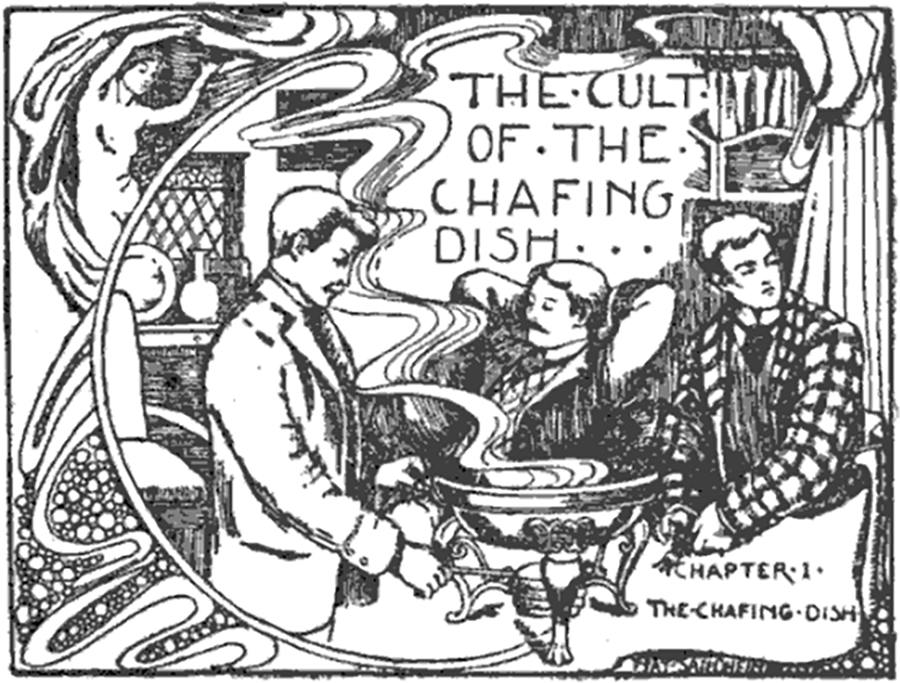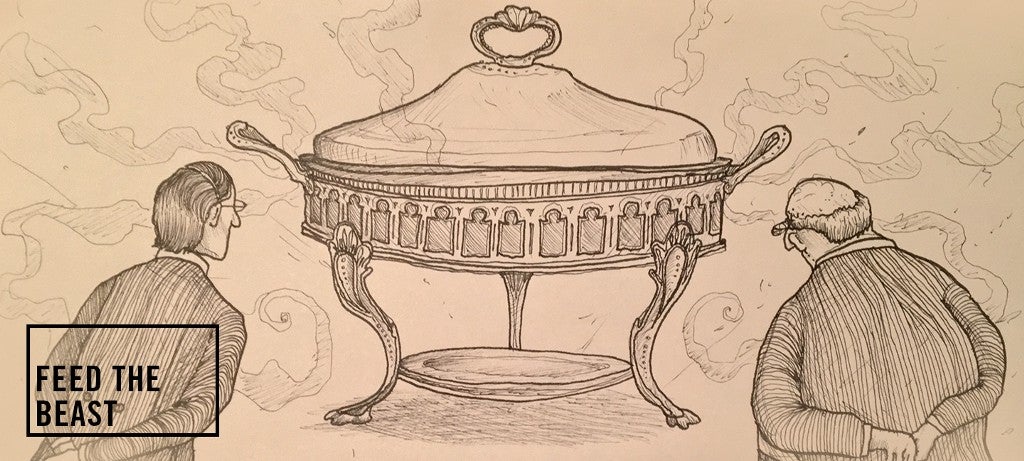Men: They’ve always eaten food. But over the years, what they’ve eaten — and what’s been marketed to them to eat — has changed. That’s why MEL enlisted Meg Favreau, a weird history writer and person who eats food, to start Feed the Beast, an occasional series about the most interesting and foul food trends for dudes through the ages. First up: the chafing dish.
If you were a bachelor living in an American apartment 110 years ago, the following things were likely true:
- You or one of your loved ones were about to die in the 1918 flu.
- You’d also totally be dead if you got any kind of serious bacterial infection.
- If you cooked at home, it was in a chafing dish.
Let’s focus on that last one, because it’s much more cheerful. You know what a chafing dish is, even if you think you don’t. It’s that metal device that uses a flame to heat a double-layered tray; you’ve probably spooned spongey scrambled eggs out of one at a breakfast buffet. But in the early 1900s, it was also the wildly popular proto-microwave, a way for people — especially men — with few cooking skills and tiny apartments to make themselves a hot meal.
Despite being in vogue at the beginning of the 20th century, the chafing dish was hardly a new invention: It’s actually been around for thousands of years. In 1894’s One Hundred Recipes for the Chafing Dish, author Herbert M. Kinsley very humbly begins by suggesting that “the Chafing Dish has played no small part in the civilization of the world.” He then walks the reader through the Forrest Gump of kitchen appliances, suggesting that the chafing dish has always been there at humankind’s greatest turns, whether it was fulfilling “its true office as the promoter of man’s palatable pleasures at the tables of the wealthy Greeks and Romans” or showing up after the American colonists had “overcome the difficulties incidental upon the making of a new country, [and] began to appreciate and to desire the luxuries and adornments of refined living.”
While there were certainly those who still used the chafing dish as part of an elegant table service in 1894, by that time, Kinsley was waxing poetic about what was basically the turn-of-the-century Hot Pocket heater. The Oxford Companion to Food, a 1999 publication that’s exhaustive enough to have several paragraphs on chafing dish cooking and exactly zero mentions of Hot Pockets, notes that the chafing dish’s turn-of-the-century rise in popularity was partially in “response to greater urbanization and the rise of the single male or female living in accommodation unsuited to independent cookery.”
While both men and women used chafing dishes in their apartments, they found a particularly devoted audience among men. In the early 1900s, multiple dudes wrote books professing their love of the chafing dish. In his book The Cult of the Chafing Dish, Frank Schloesser referred to the chafing dish as his wife, “Chaffinda.” Chaffinda, said Schloesser, “has at least seventeen hundred and four different charms, therein somewhat exceeding the average number appertaining to her sex.” With compliments like that, you’d think he’d have to buy extra locks just to keep the human women from beating his door down.
Obviously, Schloesser wrote his book with a good deal of humor, but his adoration for the chafing dish was real:
To bachelors, male and female, in chambers, lodgings, diggings, and the like, in fact to all who “batch”; to young couples with a taste for theatres, concerts, and homely late suppers, to yachtsmen, shooting-parties, and picknickers; to inventive artists who yearn for fame in the evolution of a new entree; to invalids, night workers, actors and stock-brokers, the Chafing Dish is a welcome friend and companion.
He also was eager to fight off the chafing dish’s detractors, noting that “the ordinary domestic cook” called the chafing dish “fiddle-faddle.” But, he argued, “it is clean, economical, speedy and rather simple.”
(Lest you think Schloesser was rah-rah cheerful about everything relating to the chafing dish, know that he also goes off on rants about American cooking, British cooking, gluttons, people who dislike apple dumplings, and mayonnaise, noting of the latter: “At its best it is simply a saucy disguise to an innocent salmon or martial lobster, reminding the clean-palated of an old actor painted up to look young. I once knew a man who proposed to a girl at a dance-supper simply because he could not think of anything else to say, and suddenly discovered that they both hated Mayonnaise. I have no reason to suppose that they are unhappy.”)

Schloesser’s chafing-dish boosterism echoes what many said about the microwave years later. As Marie T. Smith put it in her practical-but-sadly-titled book Microwave Cooking for One: “I’ve read a number of newspaper articles recently in which the authors of so-called gourmet cookbooks smugly dismiss microwave ovens, saying that they cannot turn out good food. I, on the other hand, have found this to be untrue.”
Of course, both the microwave and the chafing dish found popularity among men not just because of spatial concerns, but because they allowed men to make tasty meals without a lot of training, since men weren’t — and often still aren’t — taught how to cook. The early 1900s magazine The Bachelor Book (“It is intended for bachelors, but others may read it”) included two recipe sections in each issue: cocktails and chafing dish recipes. And in what might be the best-titled book ever, The Bachelor and the Chafing Dish: With a Dissertation on Chums, Deshler Welsh repeatedly stuns the aforementioned chums with the ease of chafing-dish cooking, relating conversations like this:
“I say old chap,” says he, “I’m deucedly hungry — what’s in the larder?”
“Nothing but mushrooms,” I reply.
“Ye gods!”
I knock the ashes from my pipe and poke the fire a bit.
“Well you are a good un,” says Jim. “Nothing could be better. But oh, for a broiled mushroom on toast!”
“You shall have it.”
“In a chafing dish? Come off old man!”
But perhaps the chafing dish’s greatest use in the bachelor apartment was the greatest use of any kitchen appliance: heating cheese for drunk people. “Welsh rarebit” might sound fancy, but it basically just means “hot cheese sauce on bread” (the British equivalent of queso fundido), and it was the number-one recipe for chafing dishes. Literally — it’s the first recipe listed for the chafing dish in multiple books from the time. And in an issue of the aforementioned Bachelor Book, writer Albert Hardy mentions that the time to eat Welsh rarebit (or, as it was sometimes called, “Welsh rabbit”) was late at night, at a time “when no other dish would be acceptable.”
If you’re already familiar with cheese and bread, it will probably not surprise you to know that Welsh rarebit is goddamned delicious. The good news is that you don’t need a chafing dish to make Welsh rarebit — you can cook it on your stovetop. Or, yes, if you’re a proper bachelor — in your microwave.
